Round 1 of the new Super Rugby season delivered four upsets from seven games last week, delivering a 13.11 unit profit on a total of 7 units wagered on the underdogs. Having more upsets than normal in the first round isn’t surprising given the player turnover and coaching changes during the off-season. These increase the amount of uncertainty going into the start of the season.
With the level of uncertainty elevated at the beginning of a season, is it profitable to back every underdog in week 1? We use recent historical data to answer this question. The results are split into two sections: head-to-head betting and line betting.
Head-to-head Betting
Data
The data set we have used consists of first round matches for the following eight leagues, with the season ranges listed below:
A-League from 2009/10 to 2014/15
AFL from 2010 to 2014
EPL from 2007/08 to 2014/15
NBL from 2010 to 2015
NFL from 2007 to 2015
NRL from 2009 to 2014
Super Rugby from 2009 to 2015
T20 Big Bash League from 2011/12 to 2014/15
For each league we have used average closing odds across numerous bookmakers.
Betting Strategies
For each round we tested the profitability of the following strategies:
1. Back the home team
2. Back the away team
3. Back the home team if they are the favourite
4. Back the away team if they are the underdog
5. Back the away team if they are the favourite
6. Back the home team if they are the underdog
7. Back the favourite
8. Back the underdog
For each strategy we wagered 1 unit on each fixture where one team satisfied the condition applicable to the strategy. The team with the shortest odds was defined as the favourite and the team with the longest odds was defined as the underdog. The selected team was backed in the head-to-head market.
Win Tallies
The table below shows the win/loss tallies for the eight strategies above.
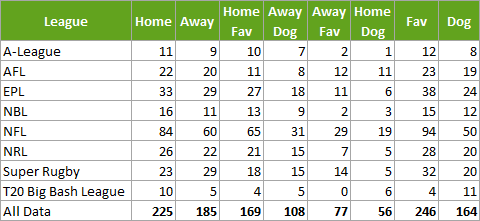
As you can see the favourites won more often than the underdogs and the home teams won more often than the away teams, but does this mean they’re the more profitable sides to back?
Betting Strategy Profits
The table below shows the unit net profits for employing each strategy discussed earlier.
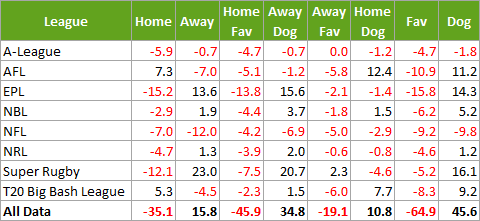
Some observations we can make are:
- Overall, backing the away teams was profitable, suggesting home advantage for Round 1 games is over-valued by bookmakers. This result only held for four of the eight leagues surveyed, suggesting home advantage is over-estimated for some sports more than others. Having said that, the small sample sizes make this conclusion difficult to make.
- Backing the home favourite was unprofitable for all eight leagues while backing the away favourite was unprofitable for every league except Super Rugby.
- Overall, backing the home underdogs was profitable, but less profitable than backing away underdogs.
- Backing all underdogs yielded a higher profit than just focusing on away underdogs.
- The A-League and the NFL were the only sports where backing first round underdogs didn’t yield a net profit.
The following table compares selected strategies. Each column subtracts one net profit from another. For example Away Profit Minus Home Profit means (-0.7 – (-5.9)) = 5.2 for the A-League. This can be interpreted as saying that betting 1 unit on each of the away teams would have yielded 5.2 units higher net profit than betting 1 unit on each of the home teams.
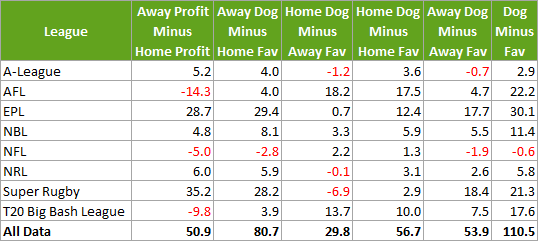
This highlights the following results for Round 1 fixtures over the past few seasons:
- Backing the away team has generally been more profitable than backing the home team
- Backing away underdogs has generally been more profitable than backing home favourites
- Backing home underdogs has generally been more profitable than backing away favourites
- Backing home underdogs has been more profitable than backing home favourites
- Backing away underdogs has generally been more profitable than backing away favourites
- Backing underdogs has generally been more profitable than backing favourites
One caveat to these results is because each first round of a season has a small sample size, the results shown above don’t hold for every season. They instead reflect a trend over the past few years. For any given year you may make or lose money by taking the underdogs, but these results suggest you would come out on top in the long-run.
Line Betting
The above strategies used the head-to-head markets, but is there an advantage to using line markets? The analysis below is based on Round 1 fixtures for the following leagues. Unfortunately the sample sizes are quite small.
AFL from 2013 to 2014
NBL from 2014 to 2015
NFL from 2007 to 2015
NRL from 2013 to 2014
Super Rugby from 2009 to 2015
Line Betting Records
Below are the line cover records for week 1’s over recent seasons.
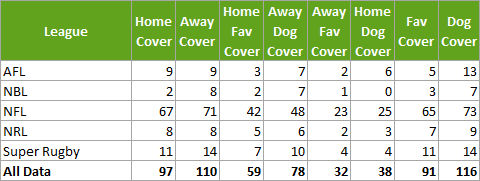
Overall we can see underdogs covered the line more often than favourites and that away teams covered the line more often than home teams. Are the gaps wide enough to be profitable?
Line Betting Strategy Profits
The table below shows the unit net profits for applying the previously discussed strategies to line markets instead of head-to-head markets. Line odds of 1.92 have been used.
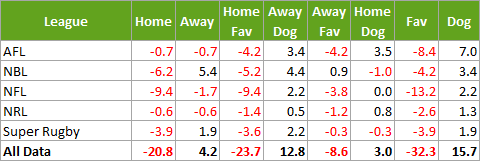
The results bear similarities with the results for head-to-head wagering. Backing the away sides and underdogs yielded better results than backing home teams and favourites. Unlike with head-to-head wagering, backing the underdog at the line yielded a positive net profit for the NFL, completing a clean sweep of profits across the surveyed sports.
The following table compares selected strategies. Like the table used for head-to-head markets, each column subtracts one net profit from another. Note that any apparent rounding anomalies are due to the profit results shown to the nearest 10th of a unit despite being calculated to the nearest 100th of a unit.
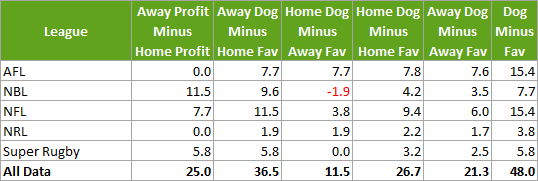
Once again it should be pointed out that the sample sizes are even smaller for the line betting analysis, but it’s remarkable how consistent the results are for each sport, with away teams and underdogs dominating home teams and favourites.
So, with the NRL and AFL seasons fast approaching, will you be on the underdogs when each season starts?


